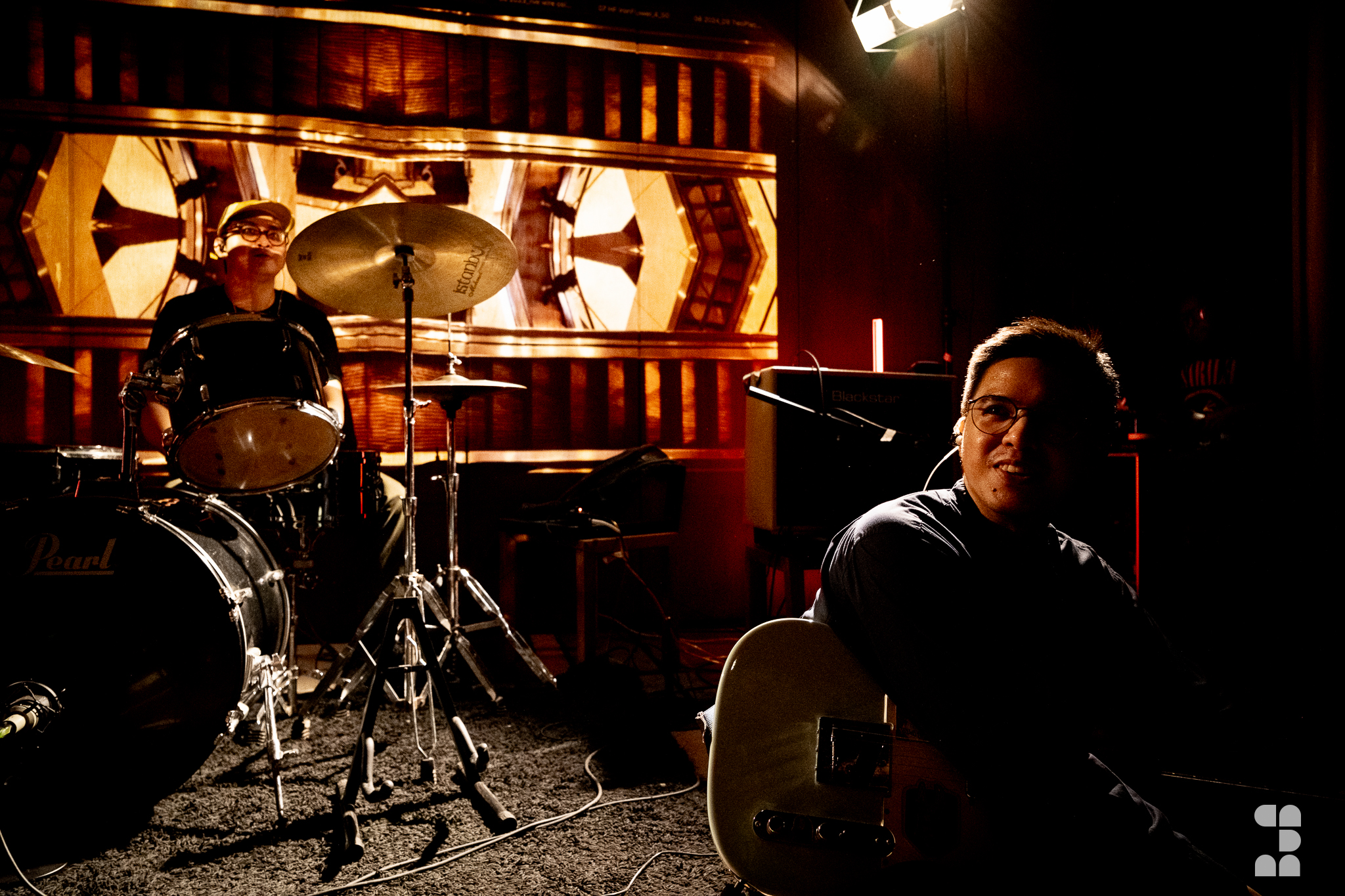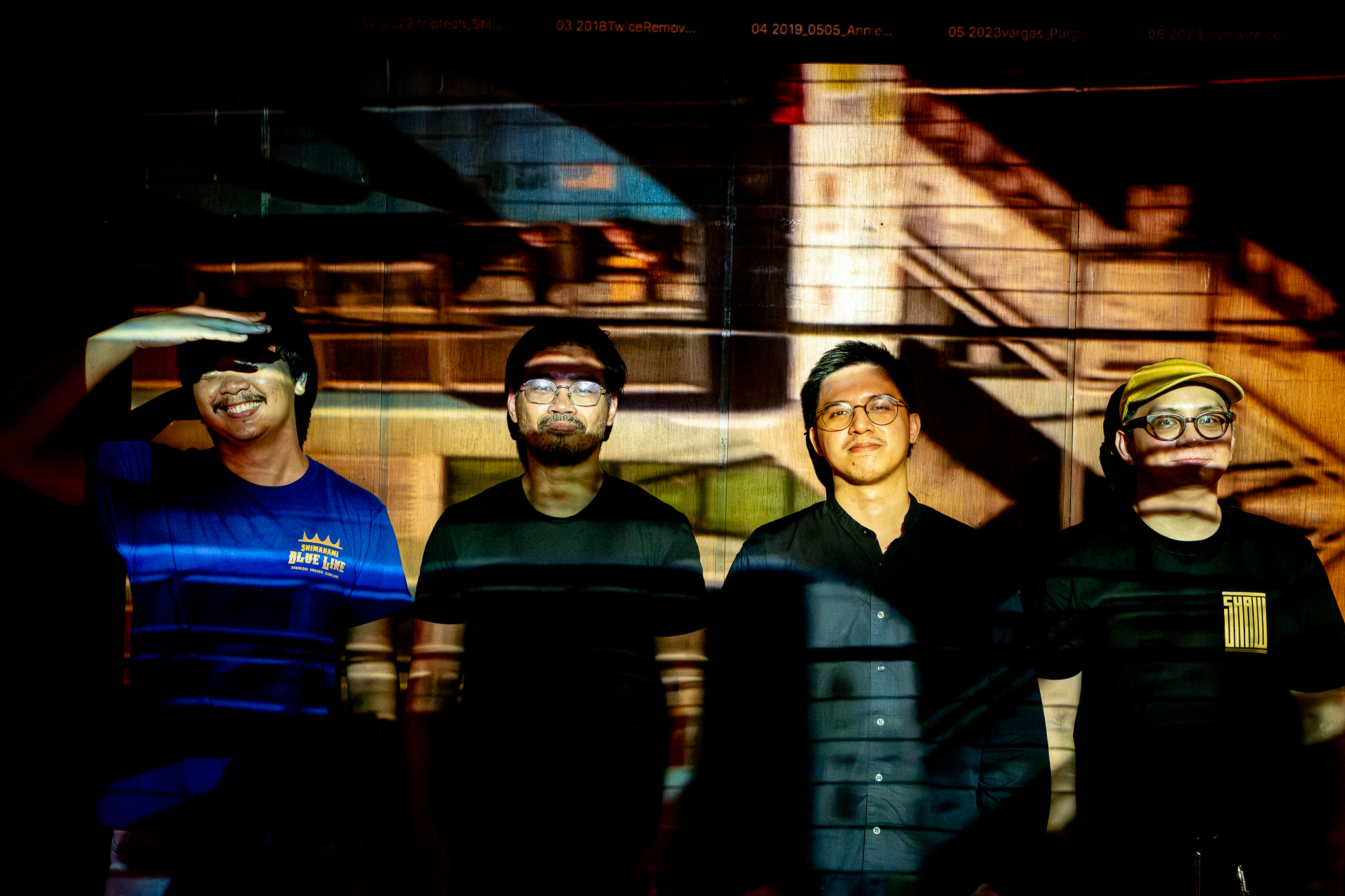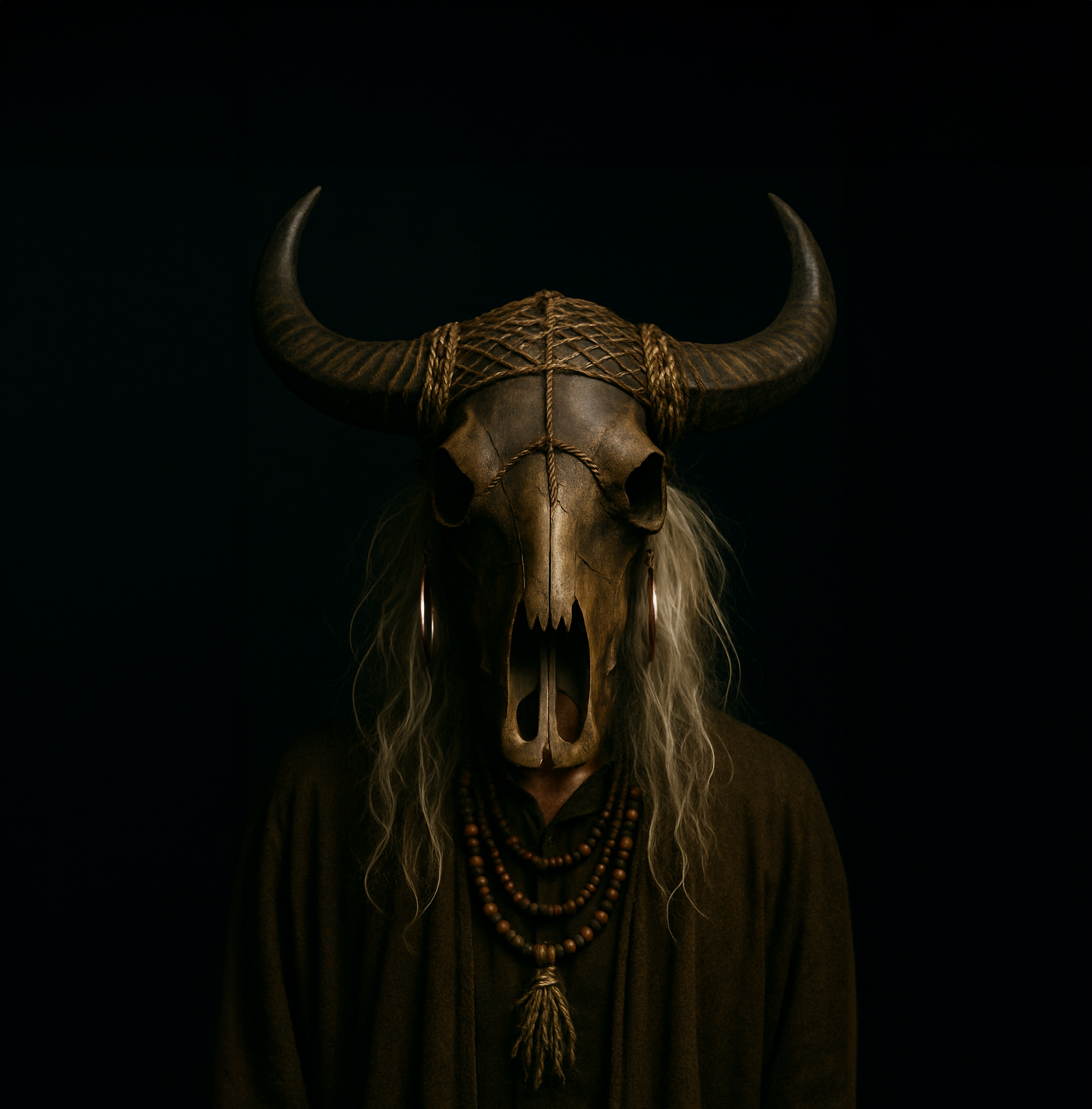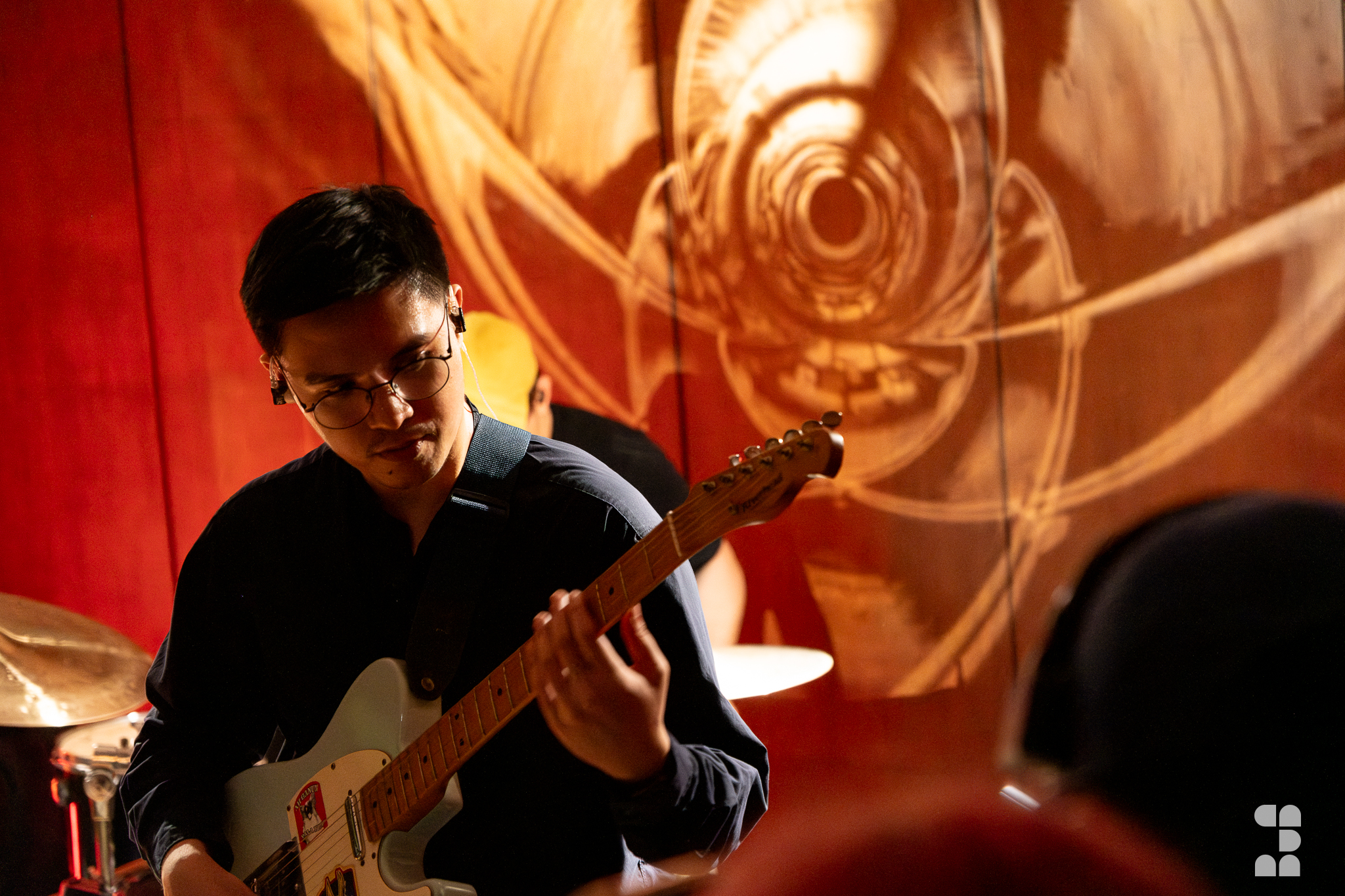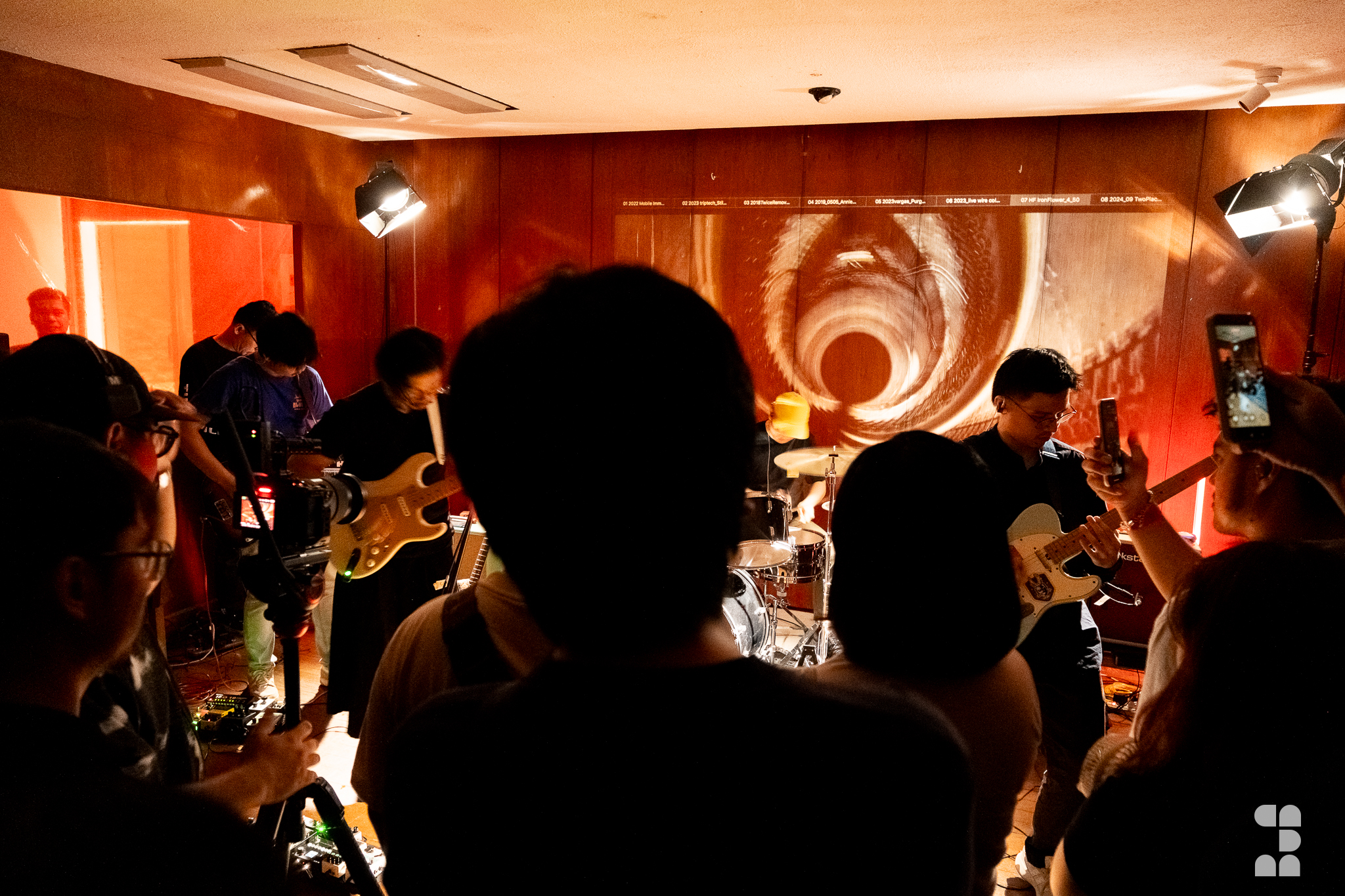One of the few surviving post-rock bands in the Philippines, Shaw launched their debut album, Book of Patterns, with an immersive collaborative performance with media artist Annie Pacaña at 1F Projects last August 16, 2025. Known for her moving image practice that draws imagery from the chaos of the urban landscape, Pacaña’s abstractions were brought into resonance with Shaw’s experimental soundscapes. The result was not illustration, but convergence: images and sounds amplifying each other, both reframed in the process.
At 1F Projects, an experimental art space in Makati known for cross-disciplinary and contemporary practices, Shaw’s music roared to life: it eased in, as though friends were simply picking up a long conversation where they had left off. People drifted in with drinks in hand, familiar faces nodded across the room, hugs were given, fans waited in introversion and excitement. By the time the first notes reverberated, the gallery had already softened into intimacy—no pomp, no fancy introductions, just a collective leaning in.
The music constellations of the night stretched out beyond Shaw. Musical O, another alternative band, entered with both weight and generosity to warm the night. Anxiety filled the air upon knowing that the vocalist couldn’t play the guitar. But when young guitarists from the audience were invited on stage, the spontaneous jamming eased the night along. Tarsius followed with electronic pieces that snapped and pulsed until rhythm itself bent into hypnosis. It ended with a collaborative session between Shaw and Annie Pacaña, creating an experience where sound and image fused—an encounter less like a concert than a passage, carrying us all somewhere uncharted.
Bassist JC Jamoralin called the collaboration “an expansion of art.”
“From the very beginning, my vision for this band was to build a space for collaboration among like-minded people. Everyone has a voice—even if, ironically, we don’t have a vocalist,” he added.
Pacaña described it as “a perfectly woven experience.” For this collaboration, she included works from her existing archive—billboard, train tracks, and abstractions repeating until chaos turned rhythmic.
“My vision is always to create a contemplative space,” she said. “Shaw’s music highlighted that, ushering the audience into their own thoughts and memories.”
Ian Somera, one of Shaw’s guitarists, captured it in one word: Setsuna. He shared: “It means in a moment, in an instant. That’s what this felt like—lightning in a bottle, captured in just a day’s preparation.”
Post-rock has long thrived on atmospheres rather than choruses, texture rather than hooks. For Shaw, the genre is less about spectacle and more about sculpting experience. This ethos shaped their choice to launch their album not in a bar, but in a gallery where music could be encountered as space. Shaw builds their sets like architecture. A riff becomes a wall, drums lay down the floor, guitars open windows.
“We wanted it to be memorable,” Jamoralin expressed. “Not just another gig. That’s why we chose a gallery. We curated every touchpoint. It had to feel different because the album itself meant so much to us.”
Kevin Arellano, one of the band’s guitarists, added: “Experiencing music is contextual. Incorporating visuals signals our intent for the audience to walk away with a multi-sensory memory.”
Their songs, although tightly arranged in the recording, still carried improvisation in the details when played live. “Some of my parts, like in the song To Miss the Forest for the Trees, are improvised every show. It evolves,” Somera revealed.
Inside 1F Projects, the sound felt warmer, the wooden walls catching and softening the echoes.
The heart of the set was Cubao Witch Doctors, one of the album’s fiercest transmissions. The guitars shimmered like neon grids, short-circuiting into trance, while drums struck like ancestral footsteps encoded in asphalt. Performed live, the song was both myth and map, a sonic portal stretching the crowd between chaos and release.
The track threads directly into Shaw’s imagery. Jamoralin conjures the Cubao Witch Doctor, a spectral icon in their posters—half folklore healer, half glitching urban ghost. “Since I’m already involved in writing the songs, I almost always have visual imagery in my head,” he explained. “The art invites people in before they even press play, and maybe carries the story after the music fades.”
That night, sound and drawing folded into each other. The Cubao Witch Doctor stepped out of metaphor into presence—an emblem of Shaw’s sonic cosmology: chaotic yet protective, its circuitry tangled with myth. The sound seemed to rise from Manila’s concrete night—humming with traffic, neon, and static—yet at the same time it reached further back, resonating with precolonial rhythms and mystical frequencies.
Pacaña’s projections translated stories into movement. She mapped her old works against Shaw’s songs, creating a chronology that drifted from industrial skeletons to meditative journeys. “During the performance, the music surfaced from dim billboard structures and train tracks, got caught in a whirl of emotions, and untangled itself to explore more adventures,” she said.
Her practice has long been about transforming disorders. “In the city, rhythm, silence, and resonance are hard to come by,” she explained. “My works reflect the attempt to transform chaos.”
With Shaw’s sound, her visuals seemed alive, pulsating hard. “With live music, the image breathes with the energy of performance and audience reception.It was like my life flashed before my eyes.” Years of work collapsed into a single fleeting instant.
Shaw discovered 1F Projects through a film scoring workshop with Musical O. “Luck was on our side,” Arellano said. “We wanted a space outside the usual venues, and 1F offered intimacy while supporting our vision.”
The intimacy was palpable. A hundred people squeezed in, the band close enough to see every expression. “Lights on us, faces right in front of us—it felt personal,” Arellano recalled.
Jamoralin highlighted the importance of alternative spaces like 1F Projects: “They give artists room to try things that don’t fit in a bar. By curating music alongside visuals, they nurture communities that value creativity in all its forms.”
As Pacaña’s first projections flickered across the walls, the room hushed. Arellano noticed it first: “They were filled with anticipation, already transported.” Pacaña saw the same awe: “They looked like they were somewhere else.”
Others described the night in broader strokes. Some called it meditative, others disorienting. Drummer Dino Solaña found it cathartic: “Post-rock can encompass all of these emotions. The last song felt like a release, and maybe that’s what the whole album is [all about].” Somera hoped the feeling would ripple outward: “Hopefully to inspire more people—create more art, write more music that’s authentic.”
For the artists, the event was as transformative as it was for the audience. Pacaña called the launch “a feast to the senses,” while Shaw saw it as “an artistic exploration.” For the rest of us, it was a portal—where a song like Cubao Witch Doctors could summon a myth into the room, where sound was not just played but inhabited, and where a space filled with both friends and music enthusiasts briefly became a shelter of resonance.
A writer, publisher and curator based in La Union, Philippines, Czyka Tumaliuan’s practice is grounded on commoning care, radical (un)learning and disability justice. She explores and hijacks the cracks between art, technology and popular culture in tropical colonies for the collective rewiring of just and sustainable futures. She is the founder of Kwago Publishing Laboratory and a member of Computer Professionals’ Union (CPU).

